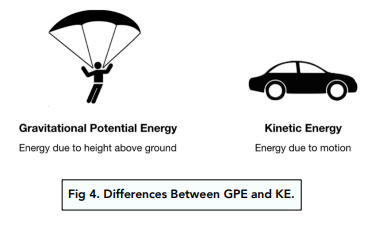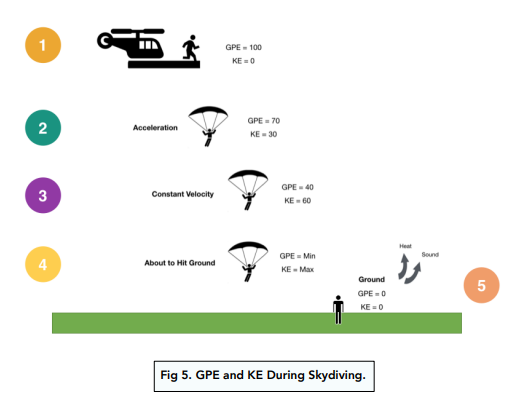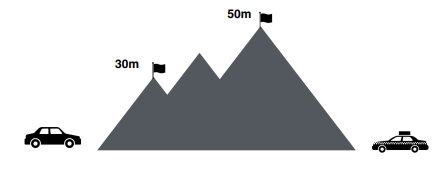Linking the KE and GPE (GCSE Physics)
Linking the KE and GPE
Conversion between KE and GPE
A classic GCSE question discusses the change between GPE and KE for a skydiver. When a person or object falls, GPE is converted to KE.
- The skydiver has maximum GPE before his jump. He is at his highest point possible, so GPE is 100 and KE is 0.
- The skydiver accelerates and GPE is converted to KE. As he begins to fall, he loses height and therefore GPE falls, and gains velocity so KE increases. All GPE lost is converted to KE.
- The skydiver continues to fall and more GPE is converted to KE. As the skydiver falls more and more, GPE continues to be converted to KE.
- Before he hits the ground, GPE is minimum and KE is maximum. As the skydiver is about to hit the ground, his KE will be at its highest level.
- As he hits the ground, GPE and KE become zero. All energy is lost as heat and sound.
Above, we have assumed that all GPE lost is converted to the KE gained. In reality, some energy will be converted to heat and sound due to friction and air resistance.


Question: Peter has climbed up his ladder, of height 3m, to put boxes into his attic. However, he drops a box of old books, of mass 10kg, from the top of the ladder, and they fall to hit the ground below. The books initially fell with a velocity of 20 m/s. What is the kinetic energy of the books just before they hit the ground? (Assume the gravitational field strength g is 10 N / kg, and that the effects of friction and air resistance are negligible).
Ignore the velocity value, as we don’t know the end velocity. The question has given you velocity values to mislead you. Instead we can work out the GPE the box had at its highest point. We can assume all of the GPE energy is transferred to KE, and none lost from the energy transfer due to air resistance and friction.
GPE = 10 x 10 x 3 = 300J.
Question: Two cars are driving up a mountain. Car A travels up to Flag A (height 30m) whilst Car B travels up to Flag B (height 50m). Both hills have a 1 in 5 slope, meaning that the cars ascend 1m for every 5m travelled along the road. Assuming that both cars have a mass of 50kg and travel at 20 m/s, work out the difference in the distance travelled by each car, the difference in gravitational potential energy at the flag points, and the difference in kinetic energy.

(g = 10 N / kg)

- Difference in KE
As we are looking for the difference in KE , the Ek=0.5mv2 formula can be re-written as:
Before proceeding with the calculation, we notice that the mass and velocity of the cars is the same. Hence, the difference in kinetic energy is zero!
- Distance travelled

- Difference in GPE at Maximum

The correct answer is D.
Kinetic energy is the energy an object possesses due to its motion. It is the energy an object has because it is moving.
Gravitational potential energy is the energy an object possesses due to its height and the strength of gravity. It is the energy an object has because of its position in a gravitational field.
Kinetic energy and gravitational potential energy are related because they are both forms of energy that an object can possess. When an object falls, its GPE decreases as it gains KE. Conversely, when an object rises, it gains GPE as its KE decreases.
The equation for kinetic energy is KE = 0.5mv^2, where m is the mass of the object and v is its velocity.
The equation for gravitational potential energy is GPE = mgh, where m is the mass of the object, g is the acceleration due to gravity, and h is the height of the object above a reference point.
To calculate the change in KE, we can use the equation ΔKE = KE_final – KE_initial. To calculate the change in GPE, we can use the equation ΔGPE = GPE_final – GPE_initial.
The conservation of energy states that energy cannot be created or destroyed, only transformed from one form to another. In the case of KE and GPE, this means that the total energy of an object remains constant as it transforms from one form of energy to another.
Work done is equal to the change in kinetic energy or gravitational potential energy. If work is done on an object, its KE or GPE will increase. Conversely, if work is done by an object, its KE or GPE will decrease.
Yes, both kinetic energy and gravitational potential energy can be negative. This occurs when an object is moving in the opposite direction to its initial velocity or when it is located below a reference point.
The concepts of KE and GPE can be used in real-world situations to understand the energy changes that occur during different physical processes. For example, in engineering, the analysis of KE and GPE can be used to design efficient machines and structures. In sports, the analysis of KE and GPE can be used to improve performance.





Still got a question? Leave a comment
Leave a comment